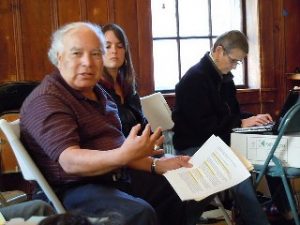Sister Cities
Resistance and Repression: Why I’m Not Hailing the Chief in El Salvador
By Alexandra Early
President Obama’s visit to El Salvador this week has become a focal point for
protest organizing by Central American social movement organizations and
their North American allies, who are equally outraged about U.S. trade
policy and military meddling in the region.Local environmental and community
organizations have joined together with allies like U.S. – El Salvador Sister Cities
and CISPES to help mobilize students and workers for rallies in the U.S. and
El Salvador on Tuesday, March 22, when Obama arrives for a meeting with
Salvadoran President Mauricio Funes, whose election two years ago ended
decades of right-wing rule.
Despite the initial jubilation at both Obama’s and Funes’s electoral
victories, both the Salvadoran left and members of the international
solidarity community are deeply disappointed and frustrated with
Obama’s stance toward Central America. The purpose of Obama´s visit is
supposedly to support the eradication of poverty, violence and
government corruption. Yet, the president’s own administration is
perpetuating these problems (and their natural result, immigration) by
following in the footprints of Bill Clinton, both George Bushes, and
even Ronald Reagan, who spent billions of dollars wreaking human rights
havoc in El Salvador and its neighbors.
Current U.S. policy on Central America reflects more continuity than
change, particularly with regard to the Central American Free Trade
Agreement (CAFTA) and the 2009 military coup in Honduras that forced
then-president Manual (“Mel”) Zelaya out of office and into exile.
It has been six years since the passage of CAFTA. As predicted by its
critics, free trade has not reduced economic inequality or created many
new jobs. Exports from El Salvador and foreign investment in the
country have both decreased; meanwhile, the price of goods has
dramatically increased while the number of small businesses able to
sell products to the U.S. has not.
Thanks to CAFTA, which supersedes national law, North American mining
companies are now suing El Salvador for $100 million because the
government has thwarted an environmentally dangerous resource
extraction scheme approved by previous governments.
Next door in Honduras, President Obama initially opposed the army’s
overthrow of Zelaya as a threat to democracy throughout the region. But
now his administration has become the leading ally and cheerleader for
Zelaya’s conservative successor, de-facto President Porfirio Lobo.
Hillary Clinton’s State Department is campaigning for re-admission of
Honduras to the Organization of American States, which strongly
condemned the ouster of Zelaya.
Since the military coup 21 months ago, and Lobo’s tainted election in
November, 2009, the U.S. has built two new military bases in Honduras
and increased its training of local police. Meanwhile, nearly all
sectors of Honduran society—union organizers, farmers and teachers,
women and young people, gays, journalists, political activists,—have
faced violent repression under Lobo’s corrupt regime. With its
worsening record of murders, disappearances and rabid resistance to
land reform, Honduras is beginning to look more and more like El
Salvador before it slipped into full-scale civil warfare three decades
ago, with the U.S. backing the wrong side then and now.
In January, I witnessed first-hand what life is like under the
“golpistas” of Honduras as part of a fact-finding delegation led by the
Honduras Accompaniment Project. We spent a week in the Honduran capitol
and countryside interviewing multiple victims of recent political
threats, beatings, jailings, and kidnappings. Human rights groups
estimate that more than 4,000 serious human rights violations and
sixty-four political assassinations have occurred in Honduras since the
coup. Many organizers have been forced to leave the country as the
threats against themselves and their families increase.
Young people are now a frequent target of death threats and actual
violence, often from police or resurgent of death squads seemingly bent
on “social cleansing.” Like El Salvador, Honduras has very strong
“anti-gang” legislation that enables cops to arrest youth who gather in
groups or on the basis of their appearance. Since the coup, it’s not
just suspicious tattoos that draw police attention. Police drag-nets
now target anyone wearing t-shirts or hats with anti-government
messages, not to mention the threatening visages of Che or Chavez. As
youth organizer Victor Alejandro explained, “many Honduran youth woke
up politically when the coup began, when they were beaten up or
arrested by the police at a march or just for walking down the street.
And now they are one of the driving forces behind the resistance, and
as a result they are one of the main targets of state repression.”
As always in Central America, organized campesinos are a target of
repression. During our stay, we visited Zacate Grande, a sparsely
populated peninsula in the Gulf of Fonseca where small tenant farmers
and fisherman are fighting eviction by rich businessmen who want to
build luxury hotels and summer homes on their land. One source of hope
and optimism for Hondurans like these was Decree 18-2008, the land
reform measure enacted under President Zelaya. It created a mechanism
for the expropriation of unused private lands for subsistence farming
and a way for the poor to gain title to land they had worked for years.
Not surprisingly, in January, the Supreme Court of Honduras ruled that
Zelaya’s land reform decree was unconstitutional.
This, combined with the rampant corruption of local authorities since
the coup, means that campesinos in places like Zacate Grande and the
embattled Bajo Aguan region in Northern Honduras are in a constant
fight for their lives and land.
Because they are part of the opposition to Lobo’s regime, public school
teachers have come under similar attack. We saw an example of their
repression during our stay in Honduras. On January 25, four teachers
were arrested after a peaceful protest march in the capital. During
their detention, our delegation got a call from a teachers’ union
leader requesting that we check on the safety of his members. When
three of us neared the jail where they were being held we encountered a
line of riot police with night sticks blocking the street. After cell
phone negotiations with the police commander in charge, we were finally
admitted to the police station and allowed to talk to the detainees in
a waiting area. Although none of the teachers had been beaten or
otherwise badly treated, they were all clearly frightened. They were
released later that same afternoon, but only on the condition that they
refrain from participating in further protests.
Two days later, we joined another peaceful and massively attended
demonstration in Tegucigalpa held on the first anniversary of Lobo’s
inauguration. The turn-out reflected a resistance movement that draws
from diverse sectors of society and whose goals go far beyond ending
the exile of Manual Zelaya. There were young people spray-painting the
walls with slogans against U.S. military intervention, teachers
shielding themselves from the sun under multi-colored umbrellas, and
embattled gay activists waiving rainbow flags. Some people were holding
banners and signs with the message “Urge Mel!” (“We need Mel!”), but
they were no more prominent in the crowd than those demanding democracy
and human rights.
This is not reflected in mainstream media coverage in the U.S., which
makes Honduras seem like just another case of caudillo politics, with
the population blindly following one populist leader after another. In
typical fashion, the Washington Post described the January 27 marches
in the capital and two other cities simply as “protests by supporters
of ousted former leader Manuel Zelaya.” As one gay activist explained,
however, “Zelaya is part of the movement, but the movement transcends
Zelaya. He gave people hope and started a process, but it is our goal
to continue and finish that process, the process of re-founding
Honduras.”
That’s why we’re greeting Obama on Tuesday with the message that his
regional track record so far includes little change that Central
Americans can believe in. Salvadorans still labor under the burden of
CAFTA and its costly barrage of big business litigation aimed at
punishing even the smallest exercises of national sovereignty.
Meanwhile, Hondurans are experiencing a rapid U.S.-assisted return to
the past, in the form of a country that is poor, militarized, and
terrorized–the same set of conditions that so many Central Americans
have long struggled to escape.

